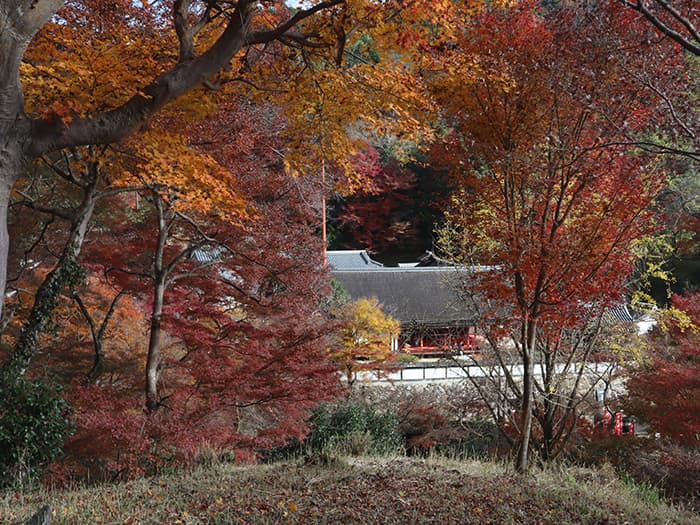Admire the autumn leaves and enjoy traditional vegetarian cuisine at Shorakuji Temple, the birthplace of Japanese sake.
“Japanese cuisine is Japan’s proud food culture. Its roots are in Nara.” The “Japanese Food Pilgrimage – NARA” project plans gastronomy tourism where you can learn about the roots of Japanese food and experience the culture. Six diverse programs are being rolled out in 2023 as well.
The fifth event took place on November 30th, with a bus tour for 20 guests to Shorakuji Temple (Bodaisen-cho, Nara City), a famous spot for autumn leaves and the birthplace of Japanese sake. We will be guided by the temple’s chief priest, Hironobu Ohara, around the temple grounds, which are in full bloom with autumn leaves.We will also listen to a talk about the history of Shoryaku-ji Temple and temple brewing, and for lunch we will enjoy traditional vegetarian cuisine, which has been restarted for the first time in four years, and Nara sake. It was a luxurious day.
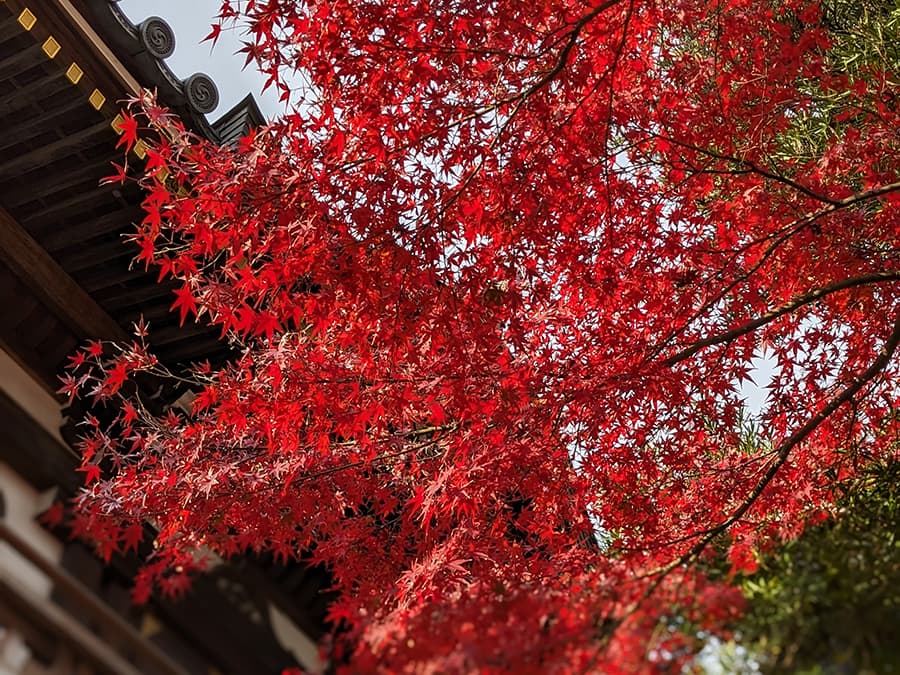
A stone monument commemorating the birthplace of Japanese sake on the brocade-dyed approach to the shrine
Chief Priest Ohara talks about temple brewing in front of the large vat used to prepare Bodaisen.
At 9am, the bus departs from Kintetsu Nara Station. Mr. Ururu Kaigo, the presiding staff member, welcomed us and explained the purpose of this tour and the itinerary of the day. “Nara has food, Chinese herbal medicine, and alcohol that have roots going back 1,300 years, so it can be said that the roots of gourmet food are in Nara.” “I want to create a program that will make people say “○○○!” when they think of Nara.”
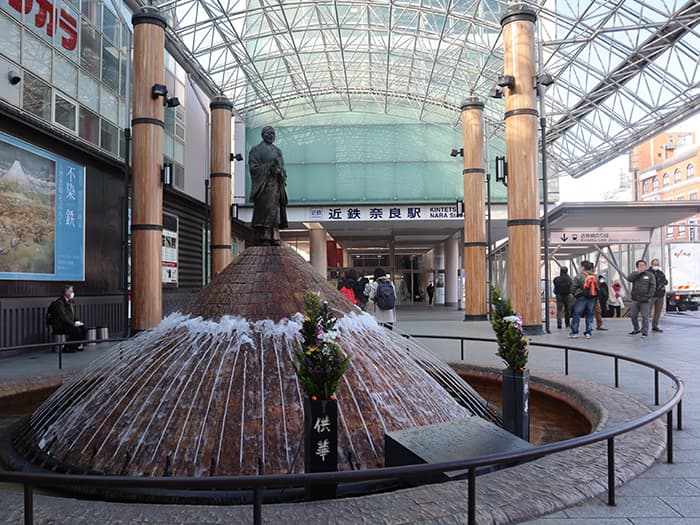
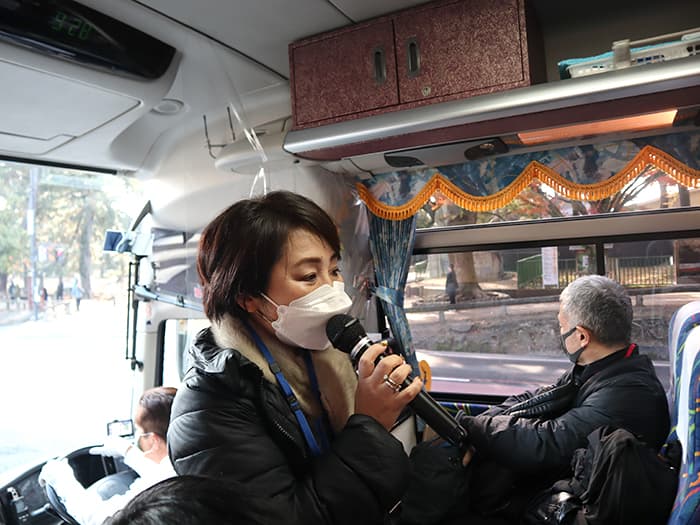
While watching a DVD of “Nara Sake,” one of the roots of sake, the group heads to Shorakuji Temple, an ancient temple in the southeastern part of Nara City. As we approached the temple, we saw a rural landscape with fields that had just been harvested.
With the autumn leaves shining brightly on a sunny autumn day, I sat down at the desk at the Rest Area Seiryuan in front of the parking lot and heard from Chief Priest Ohara about Shorakuji Temple, the history of Japanese sake brewing at the temple, and the revival of Bodhimoto. We asked him about the story behind the birth of Shorakuji Temple’s original sake, Bodaisen. Mr. Dai Komai, representative and chief brewer of Kikuji Brewing Co., Ltd., who was also present, spoke about the efforts of the restoration project “Nara Prefecture Sake Production Research Group Using Bodhimoto”.
By the way, the brewing jar and steamer for the sake brewery “Bodaisen”, which was started two years ago, are installed in that place.
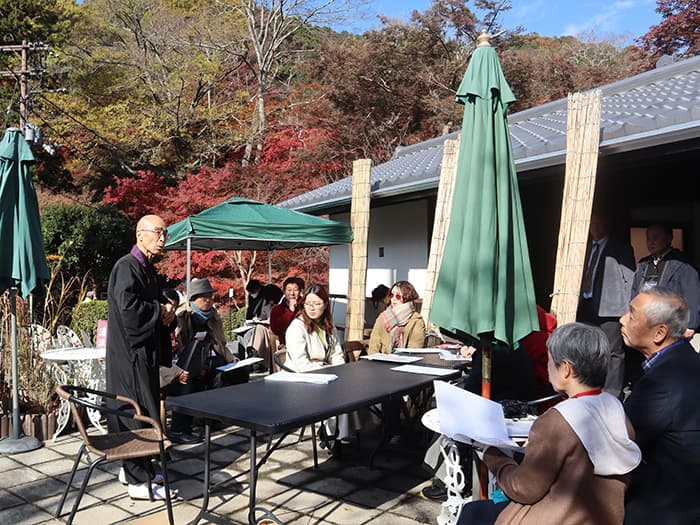
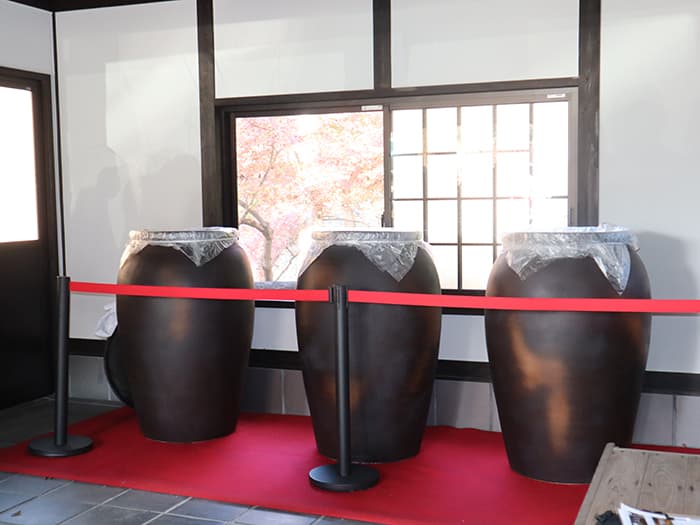
A monk's sake in a large religious city that used to be temple territory 4-5 km to the north. Revival of Bodhimoto in the Heisei era by unraveling the ``Goshu no Nikki''
Shoryaku-ji Temple was founded in 992 by the imperial order of Emperor Ichijo, and at first it was a large temple area with 86 subsidiary temples lined up around the hall. Although it was on the brink of decay due to repeated military fires, it was miraculously revived each time, and during the Muromachi period it flourished as a religious city that surpassed its predecessor.
During the Muromachi period, the “bodhimoto-zukuri” method, which became the original form of Japanese sake, was established. Originally, sake was offered to the gods, but sake brewing was also used as a financial source for temple management. We earned profits by selling alcoholic beverages that had been pasteurized to ensure stability in taste and quality. It is said that the period from 1400 to 1550, centered around Shoraku-ji Temple, was the heyday of Sobo Sake.
However, as the center of politics moved to Edo, production gradually decreased due to transportation costs, and consumption of sake decreased further between the Showa and Heisei periods. The temple collaborated with people from the prefecture’s sake brewing industry, research institutes, and universities to launch a restoration project called the Nara Prefecture Bodhimoto Sake Production Research Group.
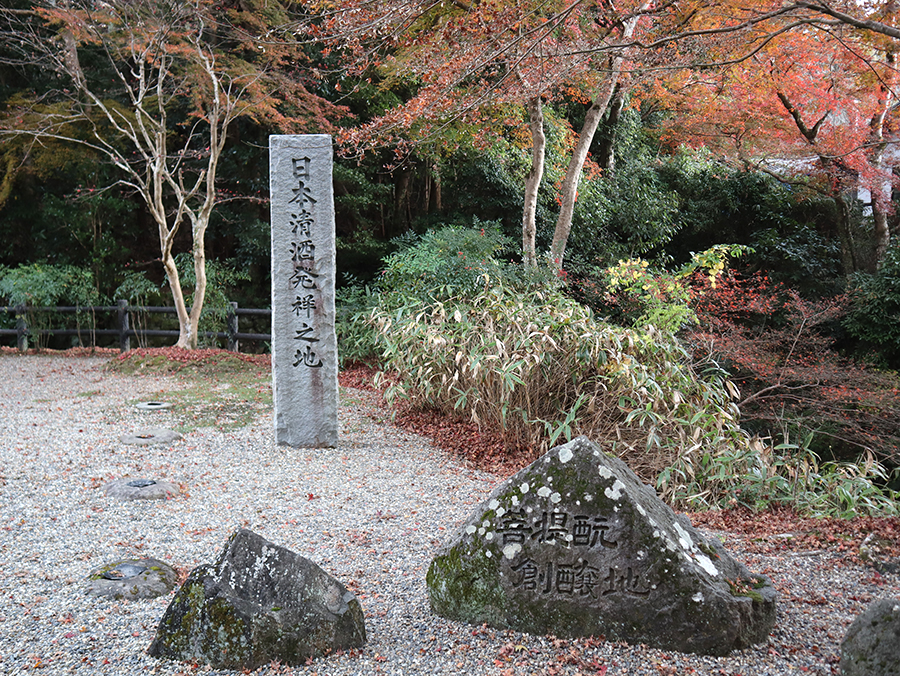
Based on the manufacturing method found in the Muromachi period’s “Goshu no Nikki,” yeast and lactic acid bacteria indigenous to Shorakuji Temple were collected and cultured, and the production license was granted in 1999 to revive Bodhimoto (shubo) on the same grounds. ” began construction. We also manufacture and sell “Bodhimoto Junmai Sake,” which is made by brewer volunteers (currently 7 breweries) using the “Bodhimoto” that they each brought back to their own breweries.
The chief priest says there are two key points to preventing sake from spoiling: “soyashi water” (sterilized water fermented with lactic acid) and pasteurization. “If you use soyashi water, you can brew sake even in the summer, so Shorakuji Temple’s sake is innovative and popular because it can be freshly squeezed in September,” says Komai. He further added that Shoryaku-ji Temple, which is known as the “birthplace of Japanese sake,” is the only temple in Japan to have a license to brew sake.
Guided by the chief priest, we took a tour around the temple grounds, which are dyed in brocade. From Ryujindaira to Rurikodai, the place of worship of Gozu Tenno
After the lecture was over, we took a tour around the temple grounds guided by the chief priest himself. The uphill slope to the main hall is lined with stone walls. Shoraku-ji Temple is called the “Mountain Temple,” “River Temple,” and “Autumn Leaves Temple,” but it is also said to be the “Stone Temple.” I turned around and headed down the main hall, enjoying the teriyaki maple leaves and scattered maple leaves. There is a place where a large number of stone Buddhas form a wall.
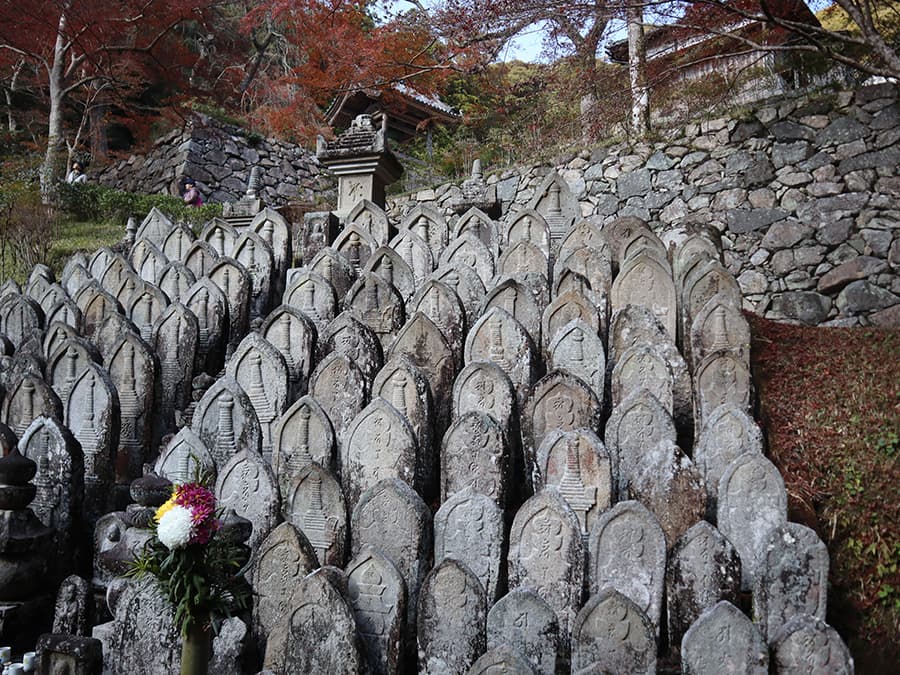
“These are the graves of the monks who died here.They come in various sizes, but they don’t tell us about their rank, but rather the economic circumstances of the temple, their rise and fall,” he said, making everyone laugh. Masu. From there, climb further to Ryujindaira.
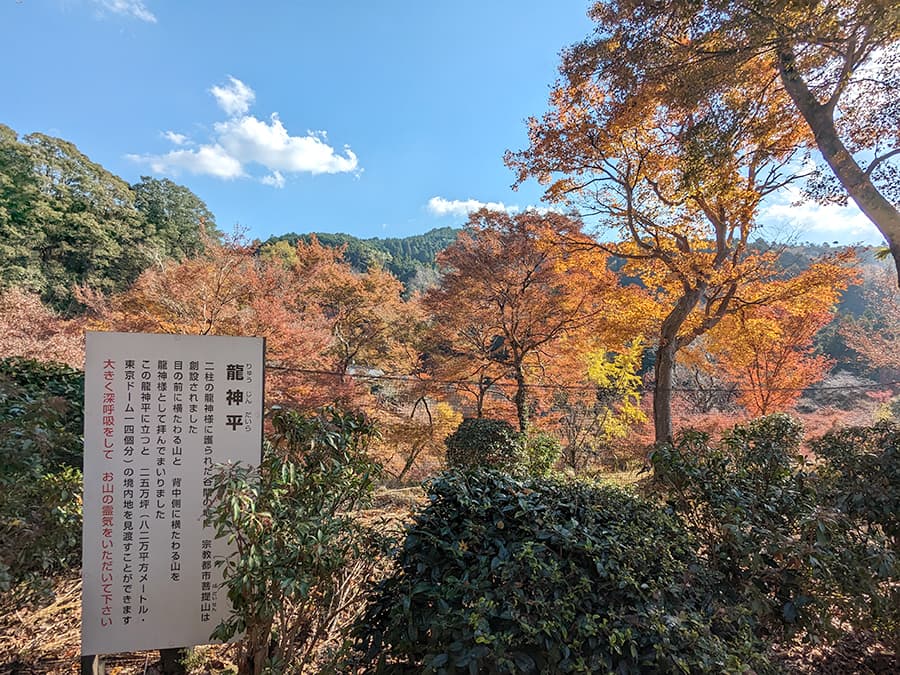
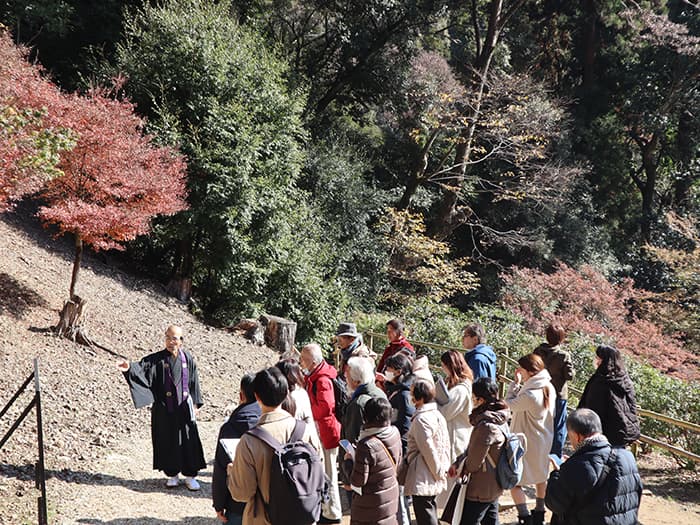
There, you can see the grounds including Fukuju-in Temple below, and if you turn your eyes upward you can see Aogaki. “It looks like a reclining dragon, right? There is also a mountain in the back that looks like a reclining dragon.The Bodhi River flows between the two dragons, which is said to be connected to the idea of Mt. “A religious city was established here because of Reimu,” said the chief priest.
From the side of the main hall, there are a few steep stone steps, and at the top is Rurikodai. Bow twice, clap twice, and bow once to Youkou-ishi. From there, you can worship the god “Guzu Tenno” at the top of the mountain. It seems that everyone was praying for a complete end to the coronavirus and world peace to the Buddhist god and the god of eradicating epidemics.
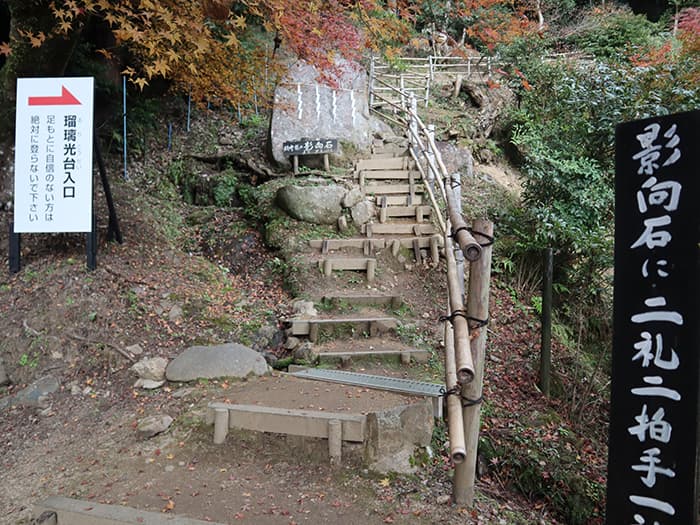
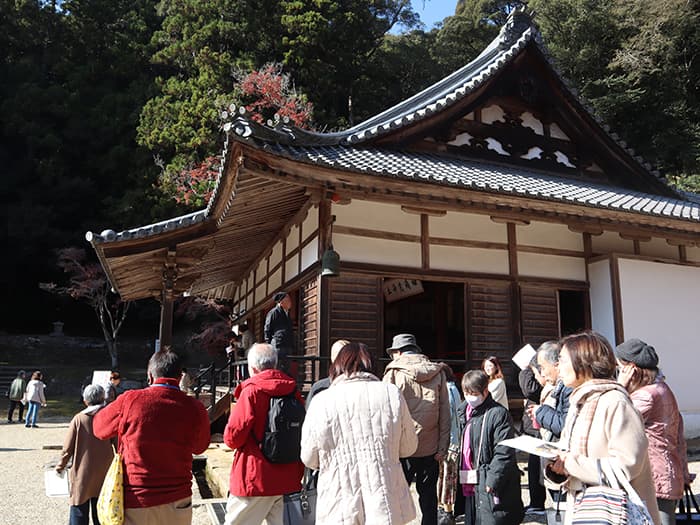
Worship the statue of Yakushi Nyorai in the main hall and admire the nishiki-e paintings from the guest hall of Fukujuin.
In the main hall, we placed our hands together with the two main idols, “Yakushi Nyorai” and the 1,300-year-old statue of “Yakushi Nyorai (National Important Cultural Property),” and we were able to view Kano Hogai’s “Images of the Twelve Heavenly Kings.” It is said that Hakuhobutsu’s Yakushi Tathagata statue had a strange fate in that it escaped the fire because it was stolen.
Head to the Fukujuin guest hall (Edo period, nationally important cultural property) with its stunning brocade scenery. From the entrance, there is a point where you can see three types of roofs: the shingled roof of the Sukiya-style building, the central gate with cypress bark in the foreground, and the main gate with tiled roof. “It tells the story of Kyoto culture,” says the chief priest.
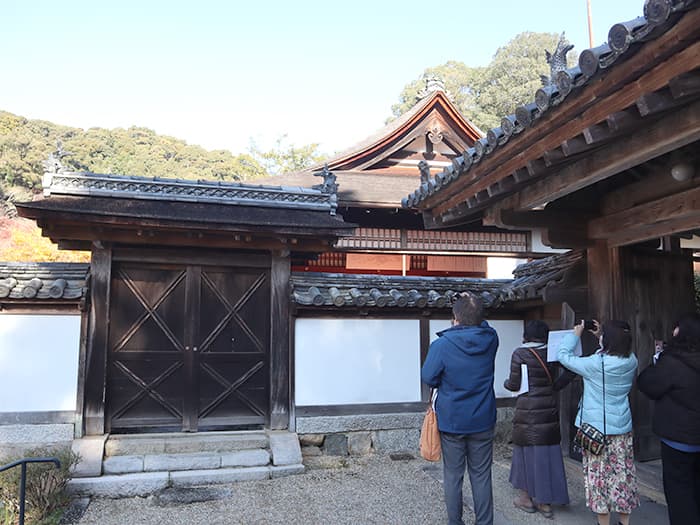
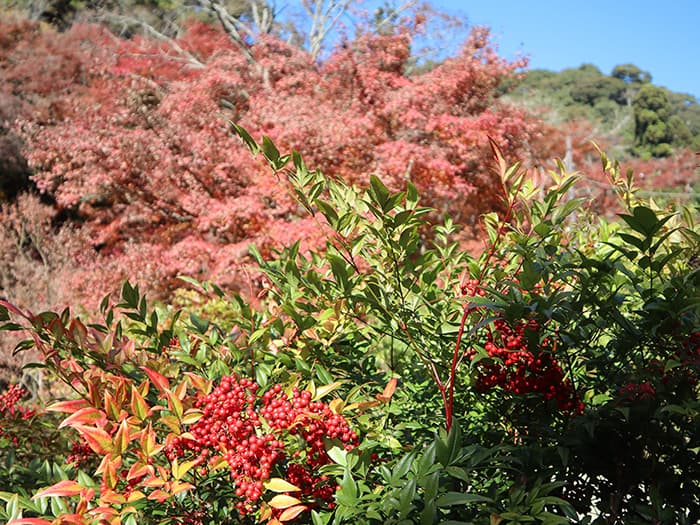
As soon as I entered the guest hall, what caught my eye was the autumn leaves and yellow leaves that filled my field of vision. It is a natural landscape style garden with an inner garden backed by a white wall and natural trees outside of the temple area. Everyone sat on the scarlet carpet and listened to the chief priest’s story while being captivated by its beauty.
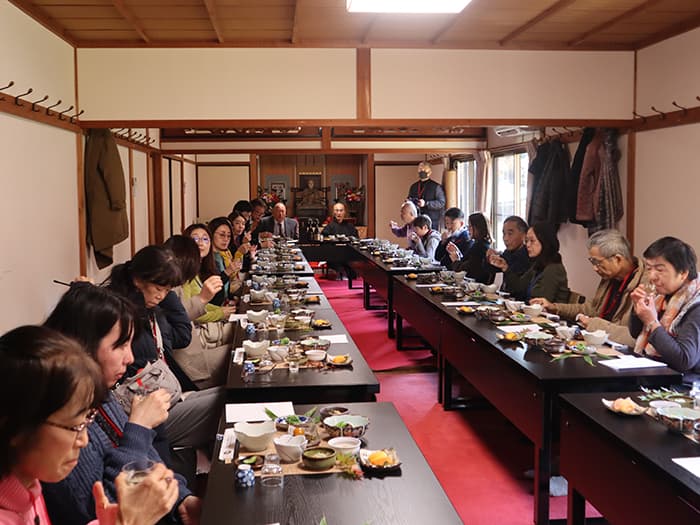
Lunch time with Nara sake such as the traditional vegetarian cuisine ``Kaede Gozen'' revived for the first time in 4 years and the monk's sake ``Bodaisen''
After moving to Tokuzo-in Temple, we had a long-awaited lunch. Shojin ryori, a specialty of Shorakuji Temple, has been revived for the first time in four years due to the coronavirus pandemic. In line with this, starting in 2021, after a toast with Shoryakuji Temple’s original rare sake “Bodhisen” brewed with the rice “Tsuyuhakaze” cultivated within the temple grounds and the Iwashimizu water that springs up within the temple grounds, we will offer “Bodhimoto” revival team’s 7 breweries. We were able to freely taste and compare 7 types of Bodhimoto Junmai.
The dishes are all homemade, mainly using rice and vegetables grown within the temple grounds. Mayumi Ohara, the chief priest’s wife, explained the cooking process with the vegetables in hand. As an appetizer, the clay brush and bracken that had been preserved since spring were also lined up, reminding us of the ingenuity of the mountain village diet.
Rare Itonankin vinegared dishes and edible chrysanthemums were served in tempura as well as in vinegared dishes. The rice was black rice with chestnuts, and everyone said, “Everything was lightly seasoned, and you could really taste the flavor of the ingredients,” and “It was a dish that clearly showed the amount of time and effort that went into preparing simple ingredients.” it was done.
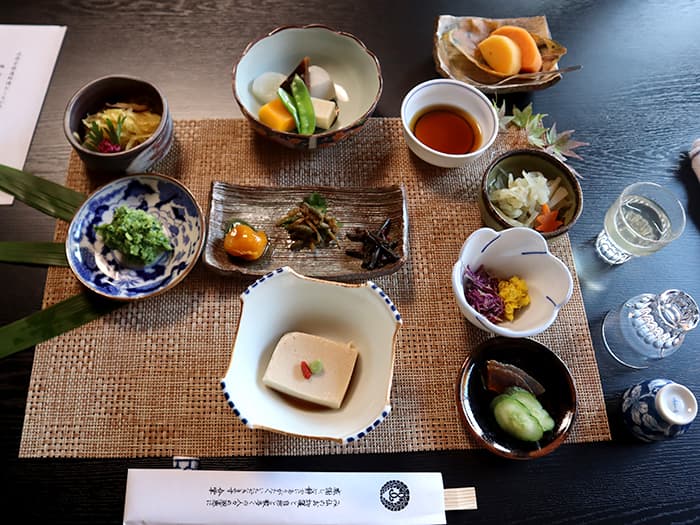
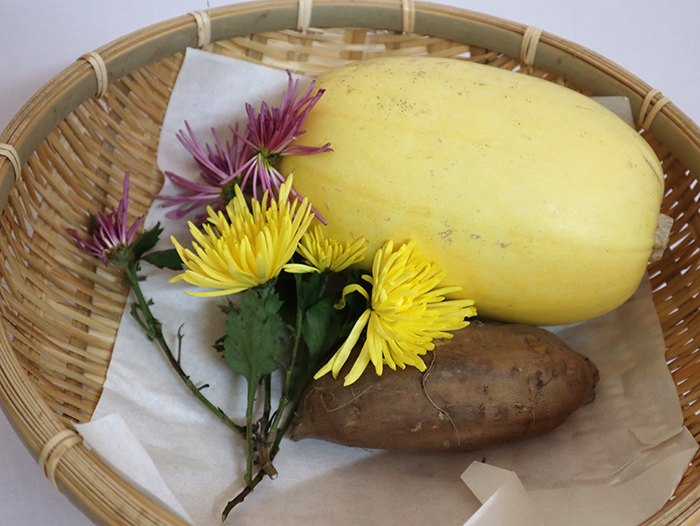
After filling their bellies, we asked them questions and asked their impressions about the taste of Bodhi Izumi and 7 Kura’s Bodhimoto. When asked, “Where does the rice come from?” and “Where in the preparation process does the difference between sweet and dry come from?” Mr. Komai replied, “The rice is grown within the temple territory,” and “The more times you prepare the rice, the sweeter it becomes. It’s a strong sake, and there’s also a 10-dan brewed sake,” he answered politely.
Bodhisen received positive reviews overall, with comments such as “The taste of koji is strong at first, then gradually absorbs, and lingers on the aftertaste” and “It has a sour taste and is easy to drink.” Regarding “Bodhimoto Junmai” from 7th Kura, people had different tastes, but one common opinion was that “the difference in temperature from hot to lukewarm is very flavorful.” According to Mr. Komai, the taste of sake is evaluated at room temperature (15℃).
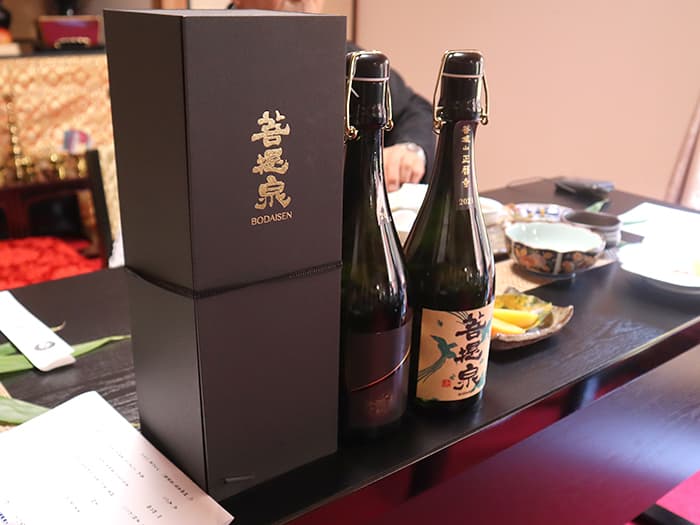
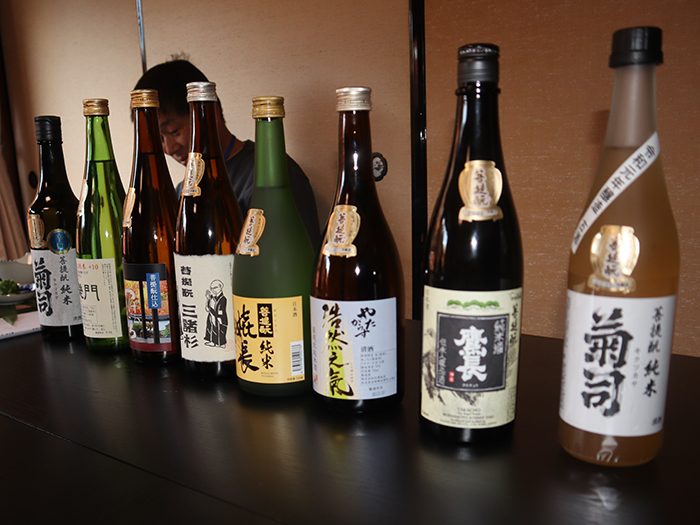
After the meal, in a separate room, the chief priest served his wife’s special stewed astringent skin as tea sweets, and made some appetizers himself. The astringent skin stew, which was particularly popular, uses large chestnuts from Tanba, the wife’s hometown, and takes seven days to make. They received generous praise, with comments such as “This is the first time I’ve had such delicious boiled astringent skin” and “This is French♪”.
After this, there was an hour of free stroll time until the bus departed at 3:00 p.m., where everyone could choose their favorite spots within the shrine grounds.
They enjoyed the autumn leaves of the temple grounds to their heart’s content, revisiting the shrine and purchasing souvenirs.

